2023届高三英语专项复习 阅读理解策略课件(共28张PPT)
文档属性
| 名称 | 2023届高三英语专项复习 阅读理解策略课件(共28张PPT) | 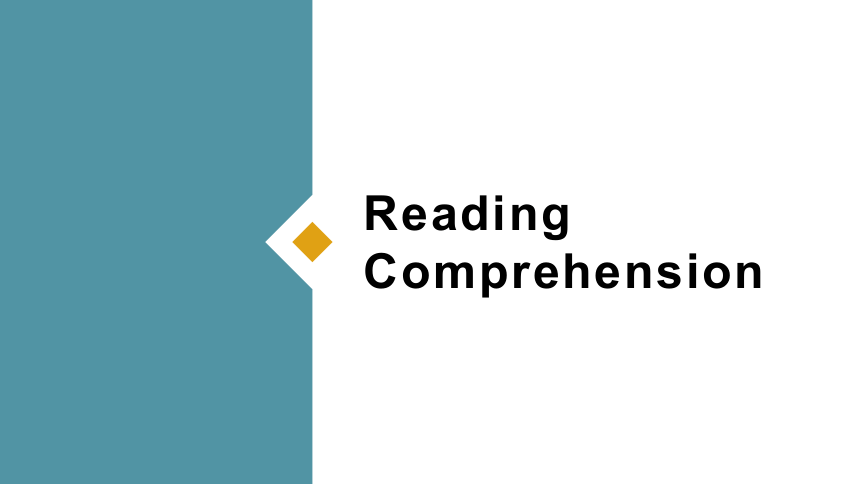 | |
| 格式 | pptx | ||
| 文件大小 | 275.2KB | ||
| 资源类型 | 教案 | ||
| 版本资源 | 通用版 | ||
| 科目 | 英语 | ||
| 更新时间 | 2024-09-09 16:08:31 | ||
图片预览

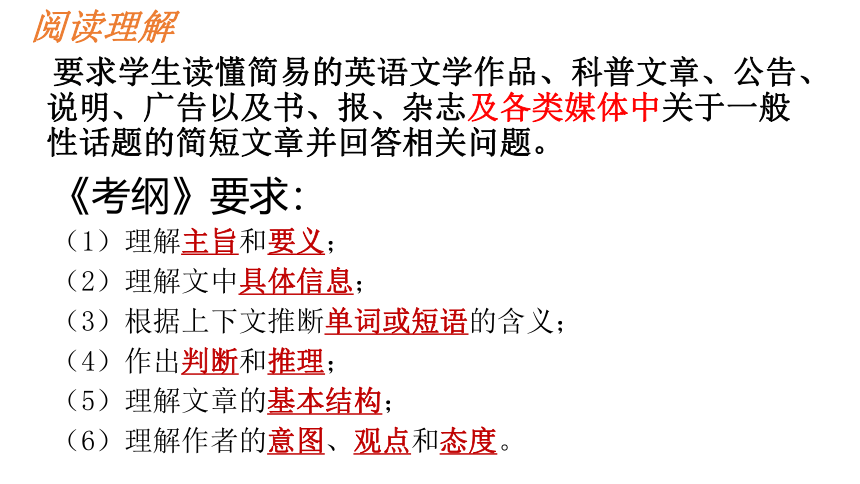

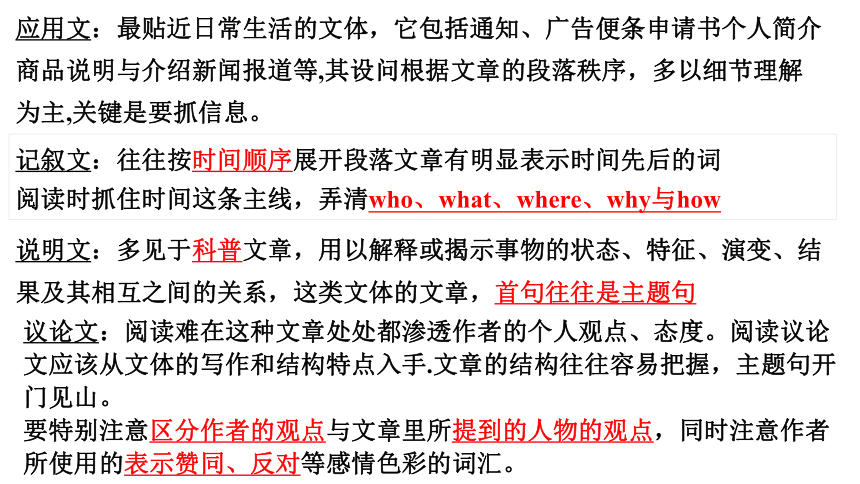
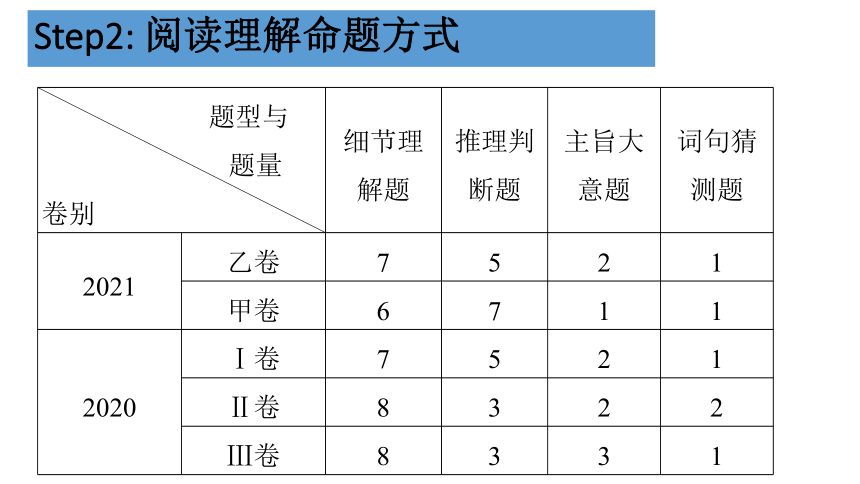
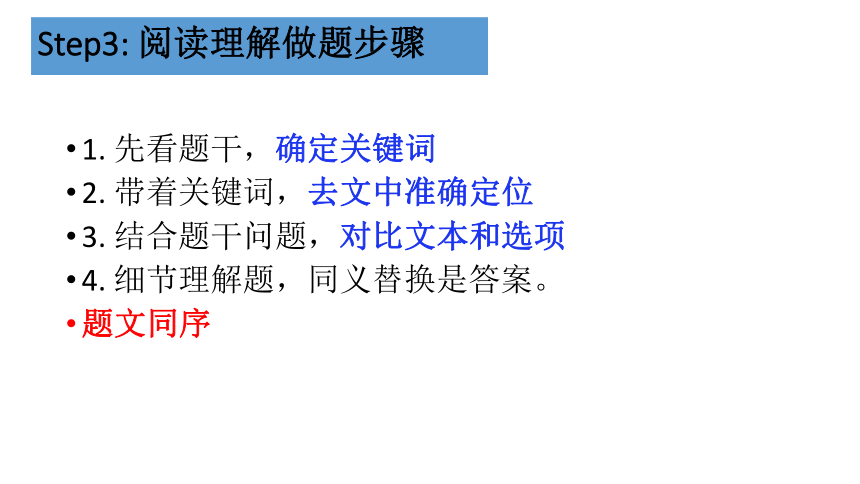
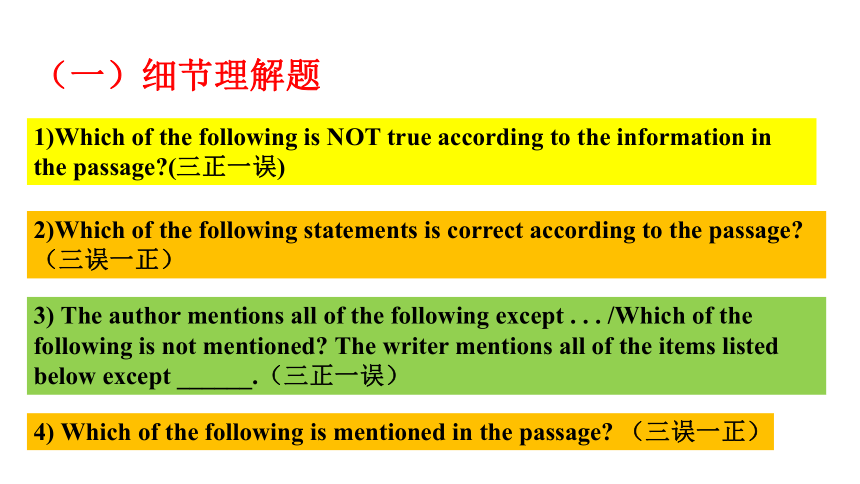
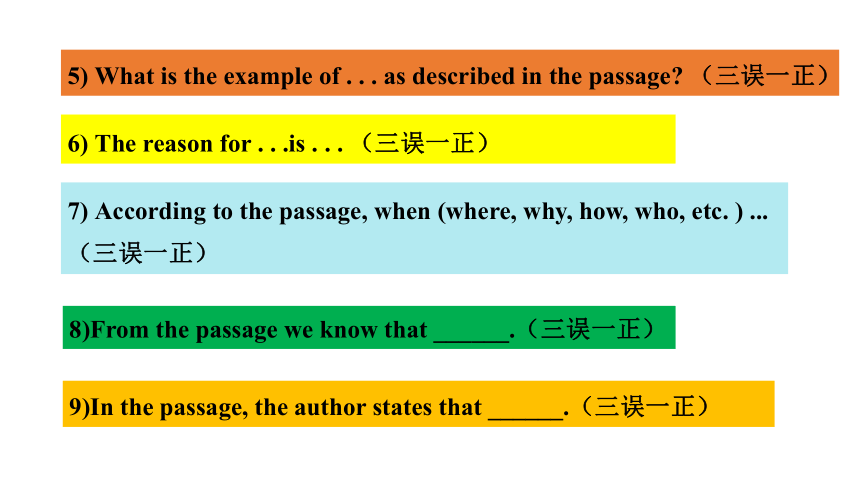

文档简介
(共28张PPT)
Reading Comprehension
阅读理解
要求学生读懂简易的英语文学作品、科普文章、公告、说明、广告以及书、报、杂志及各类媒体中关于一般性话题的简短文章并回答相关问题。
《考纲》要求:
(1)理解主旨和要义;
(2)理解文中具体信息;
(3)根据上下文推断单词或短语的含义;
(4)作出判断和推理;
(5)理解文章的基本结构;
(6)理解作者的意图、观点和态度。
Step1: 阅读理解文章体裁分析
篇目 语篇类型 主题语境
2022 乙卷 A 应用文 人与社会——艺术展
B 说明文 人与社会——书评
C 说明文 人与社会——无人机与铁路
D 说明文 人与社会——软饮料税帮助下一代拥有一个健康的童年
2021 乙卷 A 应用文 人与社会——世界上最大的几个体育场馆
B 说明文 人与社会——座机在澳大利亚的使用
C 说明文 人与自然——雕塑艺术与海洋塑料污染
D 说明文 人与自我——工作环境背景音乐对创新思维的影响
应用文:最贴近日常生活的文体,它包括通知、广告便条申请书个人简介商品说明与介绍新闻报道等,其设问根据文章的段落秩序,多以细节理解为主,关键是要抓信息。
记叙文:往往按时间顺序展开段落文章有明显表示时间先后的词
阅读时抓住时间这条主线,弄清who、what、where、why与how
说明文:多见于科普文章,用以解释或揭示事物的状态、特征、演变、结果及其相互之间的关系,这类文体的文章,首句往往是主题句
议论文:阅读难在这种文章处处都渗透作者的个人观点、态度。阅读议论文应该从文体的写作和结构特点入手.文章的结构往往容易把握,主题句开门见山。
要特别注意区分作者的观点与文章里所提到的人物的观点,同时注意作者所使用的表示赞同、反对等感彩的词汇。
Step2: 阅读理解命题方式
题型与 题量 卷别 细节理 解题 推理判断题 主旨大意题 词句猜测题
2021 乙卷 7 5 2 1
甲卷 6 7 1 1
2020 Ⅰ卷 7 5 2 1
Ⅱ卷 8 3 2 2
Ⅲ卷 8 3 3 1
1. 先看题干,确定关键词
2. 带着关键词,去文中准确定位
3. 结合题干问题,对比文本和选项
4. 细节理解题,同义替换是答案。
题文同序
Step3: 阅读理解做题步骤
(一)细节理解题
1)Which of the following is NOT true according to the information in the passage (三正一误)
3) The author mentions all of the following except . . . /Which of the following is not mentioned The writer mentions all of the items listed below except ______.(三正一误)
2)Which of the following statements is correct according to the passage (三误一正)
4) Which of the following is mentioned in the passage (三误一正)
5) What is the example of . . . as described in the passage (三误一正)
6) The reason for . . .is . . . (三误一正)
7) According to the passage, when (where, why, how, who, etc. ) ... (三误一正)
8)From the passage we know that ______.(三误一正)
9)In the passage, the author states that ______.(三误一正)
细节理解题
特殊疑问词开头的题一般都是细节理解词。解题关键就是一个字“找”!
标志词:What / How / Where / why
如果它问的是哪个是对的或哪个是错的,或者找相同点或不同点,这样的题需要你耐心地去一个一个地找!
Summary:细节理解题
1. 读完题干,确定关键词
2. 在文章中找出关键词(定位)
3. 对比(对比文章和选项有没有相同的或者相似的)
4. 同义替换就是答案
5. 如果技巧找不到答案,就在理解的基础上解题
1.标题类
1)What is the best title for the passage?/The text /passage could be entitled_________.
2)Which of the following would be suitable as a title for the passage
2. 大意类:
2)The general/main idea of the passage is about ____.
1) What’s the topic/the main idea/theme of the article
(二)主旨大意题
3. 目的类
3)The purpose of this article is to …
1)The author’s main purpose in writing the passage is to …
2)The passage is meant to ….
3)The passage is mainly concerned about ____.
4) What is the subject discussed in the text
主旨大意题正选的特点:
概括归纳的范围大小恰到好处,选项表达的尺度恰当。
干扰项的特点:
1)以偏概全:
答案只阐述了主旨的一部分,也就是局部信息。
2)主题扩大:
归纳概括太大,超过了文章要讨论的东西。
3)断章取义:
常常以次要的事实细节冒充全文主要观点。
Summary:主旨大意题
标记词:main idea / mainly about / best title
去首段/尾段直接去找,留意反复出现的词。
新闻报道,议论文和说明文:主题句在首段
记叙文,议论文:主题句一般在尾段。
在文中反复出现的词,肯定是文章的主题词。
无主题的文章,需要自己概括大意
注意首段和各段第一句话,将其含义连成一个整体
逆向思维法“如果是我写这个题目,我会怎么写?”
(三)推理判断题
1.推断隐含含义
这类题干中通常含有infer, suggest, imply, conclude等标志性词语
2) We can infer /conclude It can be inferred from the text that .
5)From the text we know that …is most likely .
4)The story implies that .
3)The writer suggests that .
1)What the writer really means is .
2.推断作者的观点或态度
解题方法
注意作者表达感彩的形容词、副词、动词及所举的例子,才能推断出作者的态度。如果问的是对某一具体事物的态度,则可以定位到具体相关句,然后确定答案。
3)The writer’s attitude toward… is______.
2)The writer thought that______.
1)According to the author ______.
positive negative
approval disapproval
objective subjective
optimistic pessimistic
indifferent reserved
neutral unbiased
critical doubtful
sarcastic/ironic ambiguous
积极的,肯定的
负面的,否定的
赞成的
不赞成的
客观的
主观的
乐观的
悲观的
漠不关心的
保留意见的
中立的
无偏见的,公平的
批评的
怀疑的
讽刺的,挖苦的
作者情感态度题词汇
模棱两可的
3.推断作者写作目的
(1) 考查整篇文章的写作目的
(2) 考查某处细节的写作意图
A. The writer’s purpose of writing this passage is to _____.
B. What is the purpose of writing this article
C. In writing the passage, the author intends to _____.
A. The writer uses the example of…to show that _____.
B. The writer uses the two questions at the beginning of the passage to _____.
C. …are mentioned in the first paragraph to _____.
常见的写作目的归纳
不同的文章可能有不同的写作目的, 但写作目的通常有以下三种:
(1) to entertain readers(娱乐读者,让人发笑)
(2) to persuade readers(说服读者接受某种观点)
(3) to inform readers(告知读者某些信息)
常见于故事类的文章。
to make people laugh; to tell an interesting experience
常见于广告类的文章。to sell a product or a service; to attract more visitors / readers / audience
多见于科普类﹑新闻报道类﹑文化类或社会类的文章 。
4.推断文章出处:
解题方法
这类问题应从文章的内容或结构来判断其出处:
(1) 报纸 (2)广告 (3)产品说明 (4)网络等
1)The passage is most likely to be taken from______.
2)Where would this passage most probably appear
3)The passage is most likely a part of ___.
解题方法
推测下文的内容:根据作者的思路进行推理,特别是最后
两三句话。
推测上文的内容:关注第一段,特别是文段开始的几句话。
5.推断上下文内容
1)The next paragraph would most probably deal with _____
2)The paragraph preceding this one would most likely discuss ______.
Summary:推理判断题
推理判断题不是选事实,而是有一个推理判断的过程,推理判断一定要基于文本,要合理。
标记词:infer / suggest / imply / learn about 等
解题方法
(1) 根据文体类别推断写作目的
(2) 从写作手法来推断写作目的
1)The underlined word(phrase)in the passage/the last paragraph means___.
2)The word "it(them)"in the first paragraph refers to __.
4)Which of the following is closest in meaning to the underlined word in the second paragraph?
3)The underlined word can be replaced by __.
(四)词义猜测题
Summary:词义猜测题
方法:上下文
标记词: mean / best explain / best describe / replace / refer to 等
1. 不认识的单词:看上句和下句,加上本句,三句话比对得出答案。
2. 认识的单词:不要直接写意思,还是根据上下文去推测,有可能考熟词生义。
3. 代词的指代:去上文找名词或事情,加上理解。
1. 绝对词否决法, 答案项中有绝对语气词的一般不是正确答案项。
这些语气词有: must, always, never, the most, all, only, have to, any, no, very, completely, none, hardly等。
A.She can’t attend her nephew’s wedding party.
B.She values the bowl from her mother a lot.
C.She is living alone near an art gallery.
D.She doesn’t care about money any more.
Step4: 猜答案方法
2. 怀疑词判断法:选项中含有不十分肯定的语气词一般是正确答案项。这些语气词有can, could, may, should, usually, might, most(大多数), more or less, relatively, be likely to, possible, whether or, not necessarily 等。
A. zoo elephants suffer less stress than those in the wild.
B. elephants are quite easy to get obese.
C. social lives are not important to elephant.
D. zoo life can be stressful to elephatn.
3. 关键词对应法:(等号前是文章中的点,等号后是选项中点)
(ABC=ABC法; ABC=A’B’C’法; ABC=CBA法; ABC≠ABD法)
4. 选项的全面性判断法
较全面、有针对性地表达文章中心思想的,选项一般是答案项。
A. to be more successful in his career
B. to solve technical problems
C. to be more specialized in his field
D. to develop his professional skill
Reading Comprehension
阅读理解
要求学生读懂简易的英语文学作品、科普文章、公告、说明、广告以及书、报、杂志及各类媒体中关于一般性话题的简短文章并回答相关问题。
《考纲》要求:
(1)理解主旨和要义;
(2)理解文中具体信息;
(3)根据上下文推断单词或短语的含义;
(4)作出判断和推理;
(5)理解文章的基本结构;
(6)理解作者的意图、观点和态度。
Step1: 阅读理解文章体裁分析
篇目 语篇类型 主题语境
2022 乙卷 A 应用文 人与社会——艺术展
B 说明文 人与社会——书评
C 说明文 人与社会——无人机与铁路
D 说明文 人与社会——软饮料税帮助下一代拥有一个健康的童年
2021 乙卷 A 应用文 人与社会——世界上最大的几个体育场馆
B 说明文 人与社会——座机在澳大利亚的使用
C 说明文 人与自然——雕塑艺术与海洋塑料污染
D 说明文 人与自我——工作环境背景音乐对创新思维的影响
应用文:最贴近日常生活的文体,它包括通知、广告便条申请书个人简介商品说明与介绍新闻报道等,其设问根据文章的段落秩序,多以细节理解为主,关键是要抓信息。
记叙文:往往按时间顺序展开段落文章有明显表示时间先后的词
阅读时抓住时间这条主线,弄清who、what、where、why与how
说明文:多见于科普文章,用以解释或揭示事物的状态、特征、演变、结果及其相互之间的关系,这类文体的文章,首句往往是主题句
议论文:阅读难在这种文章处处都渗透作者的个人观点、态度。阅读议论文应该从文体的写作和结构特点入手.文章的结构往往容易把握,主题句开门见山。
要特别注意区分作者的观点与文章里所提到的人物的观点,同时注意作者所使用的表示赞同、反对等感彩的词汇。
Step2: 阅读理解命题方式
题型与 题量 卷别 细节理 解题 推理判断题 主旨大意题 词句猜测题
2021 乙卷 7 5 2 1
甲卷 6 7 1 1
2020 Ⅰ卷 7 5 2 1
Ⅱ卷 8 3 2 2
Ⅲ卷 8 3 3 1
1. 先看题干,确定关键词
2. 带着关键词,去文中准确定位
3. 结合题干问题,对比文本和选项
4. 细节理解题,同义替换是答案。
题文同序
Step3: 阅读理解做题步骤
(一)细节理解题
1)Which of the following is NOT true according to the information in the passage (三正一误)
3) The author mentions all of the following except . . . /Which of the following is not mentioned The writer mentions all of the items listed below except ______.(三正一误)
2)Which of the following statements is correct according to the passage (三误一正)
4) Which of the following is mentioned in the passage (三误一正)
5) What is the example of . . . as described in the passage (三误一正)
6) The reason for . . .is . . . (三误一正)
7) According to the passage, when (where, why, how, who, etc. ) ... (三误一正)
8)From the passage we know that ______.(三误一正)
9)In the passage, the author states that ______.(三误一正)
细节理解题
特殊疑问词开头的题一般都是细节理解词。解题关键就是一个字“找”!
标志词:What / How / Where / why
如果它问的是哪个是对的或哪个是错的,或者找相同点或不同点,这样的题需要你耐心地去一个一个地找!
Summary:细节理解题
1. 读完题干,确定关键词
2. 在文章中找出关键词(定位)
3. 对比(对比文章和选项有没有相同的或者相似的)
4. 同义替换就是答案
5. 如果技巧找不到答案,就在理解的基础上解题
1.标题类
1)What is the best title for the passage?/The text /passage could be entitled_________.
2)Which of the following would be suitable as a title for the passage
2. 大意类:
2)The general/main idea of the passage is about ____.
1) What’s the topic/the main idea/theme of the article
(二)主旨大意题
3. 目的类
3)The purpose of this article is to …
1)The author’s main purpose in writing the passage is to …
2)The passage is meant to ….
3)The passage is mainly concerned about ____.
4) What is the subject discussed in the text
主旨大意题正选的特点:
概括归纳的范围大小恰到好处,选项表达的尺度恰当。
干扰项的特点:
1)以偏概全:
答案只阐述了主旨的一部分,也就是局部信息。
2)主题扩大:
归纳概括太大,超过了文章要讨论的东西。
3)断章取义:
常常以次要的事实细节冒充全文主要观点。
Summary:主旨大意题
标记词:main idea / mainly about / best title
去首段/尾段直接去找,留意反复出现的词。
新闻报道,议论文和说明文:主题句在首段
记叙文,议论文:主题句一般在尾段。
在文中反复出现的词,肯定是文章的主题词。
无主题的文章,需要自己概括大意
注意首段和各段第一句话,将其含义连成一个整体
逆向思维法“如果是我写这个题目,我会怎么写?”
(三)推理判断题
1.推断隐含含义
这类题干中通常含有infer, suggest, imply, conclude等标志性词语
2) We can infer /conclude It can be inferred from the text that .
5)From the text we know that …is most likely .
4)The story implies that .
3)The writer suggests that .
1)What the writer really means is .
2.推断作者的观点或态度
解题方法
注意作者表达感彩的形容词、副词、动词及所举的例子,才能推断出作者的态度。如果问的是对某一具体事物的态度,则可以定位到具体相关句,然后确定答案。
3)The writer’s attitude toward… is______.
2)The writer thought that______.
1)According to the author ______.
positive negative
approval disapproval
objective subjective
optimistic pessimistic
indifferent reserved
neutral unbiased
critical doubtful
sarcastic/ironic ambiguous
积极的,肯定的
负面的,否定的
赞成的
不赞成的
客观的
主观的
乐观的
悲观的
漠不关心的
保留意见的
中立的
无偏见的,公平的
批评的
怀疑的
讽刺的,挖苦的
作者情感态度题词汇
模棱两可的
3.推断作者写作目的
(1) 考查整篇文章的写作目的
(2) 考查某处细节的写作意图
A. The writer’s purpose of writing this passage is to _____.
B. What is the purpose of writing this article
C. In writing the passage, the author intends to _____.
A. The writer uses the example of…to show that _____.
B. The writer uses the two questions at the beginning of the passage to _____.
C. …are mentioned in the first paragraph to _____.
常见的写作目的归纳
不同的文章可能有不同的写作目的, 但写作目的通常有以下三种:
(1) to entertain readers(娱乐读者,让人发笑)
(2) to persuade readers(说服读者接受某种观点)
(3) to inform readers(告知读者某些信息)
常见于故事类的文章。
to make people laugh; to tell an interesting experience
常见于广告类的文章。to sell a product or a service; to attract more visitors / readers / audience
多见于科普类﹑新闻报道类﹑文化类或社会类的文章 。
4.推断文章出处:
解题方法
这类问题应从文章的内容或结构来判断其出处:
(1) 报纸 (2)广告 (3)产品说明 (4)网络等
1)The passage is most likely to be taken from______.
2)Where would this passage most probably appear
3)The passage is most likely a part of ___.
解题方法
推测下文的内容:根据作者的思路进行推理,特别是最后
两三句话。
推测上文的内容:关注第一段,特别是文段开始的几句话。
5.推断上下文内容
1)The next paragraph would most probably deal with _____
2)The paragraph preceding this one would most likely discuss ______.
Summary:推理判断题
推理判断题不是选事实,而是有一个推理判断的过程,推理判断一定要基于文本,要合理。
标记词:infer / suggest / imply / learn about 等
解题方法
(1) 根据文体类别推断写作目的
(2) 从写作手法来推断写作目的
1)The underlined word(phrase)in the passage/the last paragraph means___.
2)The word "it(them)"in the first paragraph refers to __.
4)Which of the following is closest in meaning to the underlined word in the second paragraph?
3)The underlined word can be replaced by __.
(四)词义猜测题
Summary:词义猜测题
方法:上下文
标记词: mean / best explain / best describe / replace / refer to 等
1. 不认识的单词:看上句和下句,加上本句,三句话比对得出答案。
2. 认识的单词:不要直接写意思,还是根据上下文去推测,有可能考熟词生义。
3. 代词的指代:去上文找名词或事情,加上理解。
1. 绝对词否决法, 答案项中有绝对语气词的一般不是正确答案项。
这些语气词有: must, always, never, the most, all, only, have to, any, no, very, completely, none, hardly等。
A.She can’t attend her nephew’s wedding party.
B.She values the bowl from her mother a lot.
C.She is living alone near an art gallery.
D.She doesn’t care about money any more.
Step4: 猜答案方法
2. 怀疑词判断法:选项中含有不十分肯定的语气词一般是正确答案项。这些语气词有can, could, may, should, usually, might, most(大多数), more or less, relatively, be likely to, possible, whether or, not necessarily 等。
A. zoo elephants suffer less stress than those in the wild.
B. elephants are quite easy to get obese.
C. social lives are not important to elephant.
D. zoo life can be stressful to elephatn.
3. 关键词对应法:(等号前是文章中的点,等号后是选项中点)
(ABC=ABC法; ABC=A’B’C’法; ABC=CBA法; ABC≠ABD法)
4. 选项的全面性判断法
较全面、有针对性地表达文章中心思想的,选项一般是答案项。
A. to be more successful in his career
B. to solve technical problems
C. to be more specialized in his field
D. to develop his professional skill
